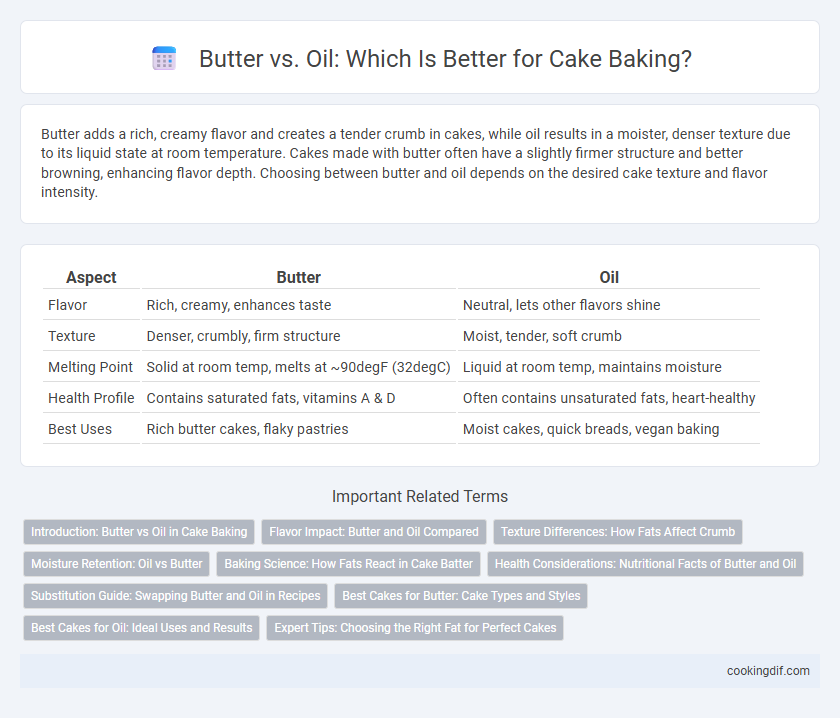Butter adds a rich, creamy flavor and creates a tender crumb in cakes, while oil results in a moister, denser texture due to its liquid state at room temperature. Cakes made with butter often have a slightly firmer structure and better browning, enhancing flavor depth. Choosing between butter and oil depends on the desired cake texture and flavor intensity.
Table of Comparison
| Aspect | Butter | Oil |
|---|---|---|
| Flavor | Rich, creamy, enhances taste | Neutral, lets other flavors shine |
| Texture | Denser, crumbly, firm structure | Moist, tender, soft crumb |
| Melting Point | Solid at room temp, melts at ~90degF (32degC) | Liquid at room temp, maintains moisture |
| Health Profile | Contains saturated fats, vitamins A & D | Often contains unsaturated fats, heart-healthy |
| Best Uses | Rich butter cakes, flaky pastries | Moist cakes, quick breads, vegan baking |
Introduction: Butter vs Oil in Cake Baking
Butter and oil serve distinct roles in cake baking, affecting texture, flavor, and moisture content. Butter imparts a rich, creamy taste and creates a tender crumb due to its solid fat structure, while oil contributes to a moister, denser cake by staying liquid at room temperature. Choosing between butter and oil depends on the desired cake outcome, with butter favored for fluffier cakes and oil preferred for rich, moist varieties.
Flavor Impact: Butter and Oil Compared
Butter imparts a rich, creamy flavor with a slightly caramelized note when baked, enhancing the overall taste profile of cakes. Oil provides a neutral taste, allowing other ingredients like vanilla or spices to shine without interference. Choosing butter or oil significantly affects the cake's aromatic complexity and flavor depth.
Texture Differences: How Fats Affect Crumb
Butter creates a denser, richer crumb because its solid state traps air during creaming, resulting in a tender yet structured cake texture. Oil, being liquid at room temperature, produces a moister and softer crumb by coating flour proteins more thoroughly, which inhibits gluten development and yields a lighter, more tender bite. Choosing butter or oil directly influences cake moistness and crumb firmness, impacting overall texture and mouthfeel.
Moisture Retention: Oil vs Butter
Oil retains moisture better than butter in cakes because it remains liquid at room temperature, preventing the cake from drying out quickly. Butter contains about 15-20% water, which evaporates during baking, leading to a drier texture. Using oil results in a moister, softer crumb compared to the firmer, richer texture provided by butter.
Baking Science: How Fats React in Cake Batter
Butter creates a tender crumb by trapping air during creaming, which helps cakes rise and develop structure, while oil produces a moister, denser texture due to its liquid state at room temperature. The saturated fats in butter contribute to a rich flavor and firmer set, whereas oil's unsaturated fats keep cakes softer and extend shelf life by retaining moisture. Understanding the chemical roles of these fats in emulsification and fat crystallization aids bakers in selecting the ideal fat for desired cake texture and flavor.
Health Considerations: Nutritional Facts of Butter and Oil
Butter contains saturated fats and cholesterol, which may raise LDL cholesterol levels, while oil, especially unsaturated varieties like olive or canola oil, provides heart-healthy fats that support cardiovascular health. Butter offers fat-soluble vitamins such as A, D, E, and K, whereas most oils lack significant vitamins but are richer in monounsaturated and polyunsaturated fatty acids. Choosing oil over butter can reduce saturated fat intake and potentially lower heart disease risk, important factors in health-conscious baking decisions.
Substitution Guide: Swapping Butter and Oil in Recipes
Butter and oil can be swapped in cake recipes with attention to texture and flavor differences; butter adds richness and structure due to its water content, while oil yields a moister, denser crumb. When substituting, use a 1:1 ratio for oil to butter by volume but reduce the oil slightly if the recipe involves creaming butter to incorporate air. Choosing the right fat depends on the cake type, with butter preferred for traditional, fluffy cakes and oil favored in moist, tender cakes like chocolate or carrot.
Best Cakes for Butter: Cake Types and Styles
Butter creates rich, flavorful cakes with a tender crumb, making it ideal for classic butter cakes, pound cakes, and yellow cakes that benefit from its creamy texture. Its ability to incorporate air during creaming enhances the rise and lightness, perfect for butter-based sponge cakes and layered celebration cakes. Cakes like butter-based carrot cakes and vanilla birthday cakes showcase butter's depth and moisture retention, producing a moist yet sturdy structure ideal for frosting and decoration.
Best Cakes for Oil: Ideal Uses and Results
Oil is ideal for cakes requiring a moist, tender crumb such as carrot cake, banana bread, and chocolate cakes, as it remains liquid at room temperature, enhancing softness. Cakes made with oil tend to retain moisture longer, resulting in a fresher texture over time compared to butter-based cakes. Using oil in recipes with strong flavors or fruits complements the taste without overpowering the other ingredients, making it a preferred choice for rich, dense cakes.
Expert Tips: Choosing the Right Fat for Perfect Cakes
Butter provides rich flavor and a tender crumb due to its ability to trap air during creaming, making cakes moist and fluffy. Oil yields a denser, moister texture that stays fresh longer because it remains liquid at room temperature. Experts recommend using butter for traditional cakes with a delicate crumb, while oil is ideal for moist, heavy cakes like carrot or chocolate varieties.
Butter vs Oil for cake fat Infographic

 cookingdif.com
cookingdif.com